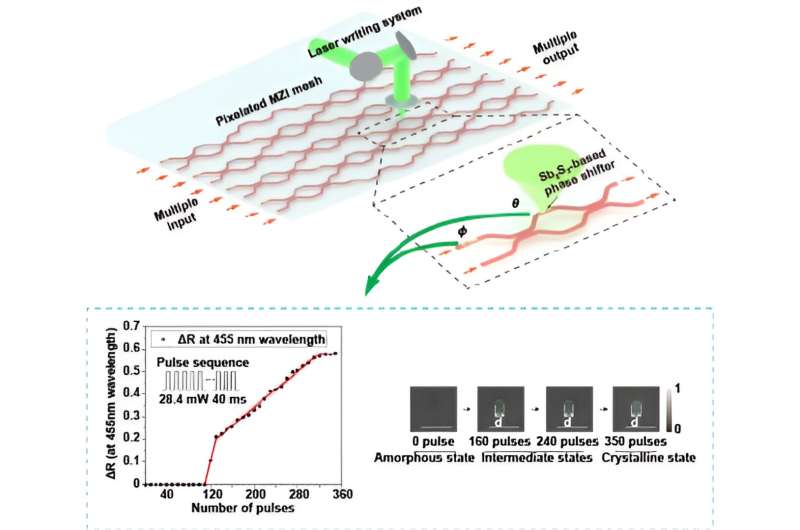This article has been reviewed according to Science X's editorial process and policies. Editors have highlighted the following attributes while ensuring the content's credibility:
fact-checked
proofread
Pixelated non-volatile programmable photonic integrated circuits proposed by researchers in China

Researchers from Huazhong University of Science and Technology proposed a pixelated programmable photonic integrated circuit (PICs) with record-high 20-level intermediate states of phase change materials (PCMs).
The work, reported in the International Journal of Extreme Manufacturing, could pave the way for the applications of laser-induced PCMs in neuromorphic photonics, optical computing, and reconfigurable metasurfaces.
Prof. Jinlong Zhu, corresponding author at the School of Mechanical Science and Engineering of HUST explains, "The research on programmable PCMs-based PICs and metasurfaces primarily utilized thermal annealing and electrothermal switching. In contrast, multi-level PCMs with free-space laser switching offer significantly enhanced flexibility in phase modulation."
Programmable PICs have emerged as powerful platforms in a variety of fields, such as optical communications, sensors, and photonic neural networks. Due to the large refractive index contrast (∆n >1 ) between the amorphous and crystalline states of chalcogenide PCMs, researchers have investigated PCMs in nanophotonic platforms to perform programmable optical functions.
While there has been significant research development on low-loss PCMs in the amorphous and crystalline states, the study of the multi-level intermediate states at the micron scale is still in its infancy. The research on programmable PCMs-based PICs and metasurfaces primarily utilized thermal annealing and electrothermal switching.
As a result, programmable PICs and metasurfaces with ultra-high flexibility in phase modulation using multi-level PCMs with free-space laser switching were rarely reported.
The researchers investigated the laser-writing multi-level intermediate states of a single Sb2S3 element at the microscale. By optimizing the power and quantity of laser pulses, 20-level intermediate states of single Sb2S3 pixels were realized in the range of 120 ~ 320 pulses. The diameter of the phase-transition pixels is about 1.2 μm, which is caused by the focused laser.
By utilizing multi-level intermediate states achieved by micron-scale laser writing system, the researchers simulated an Sb2S3-based phase shifter in a programmable Mach-Zehnder interferometer and demonstrated that it could achieve 30-level phase shift accuracy of π at 785 nm wavelength. In this way, the availability of very large-scale pixelated non-volatile programmable PICs has been demonstrated by simulation.
The Sb2S3-matrix-based programmable photonic integrated circuits could have a positive impact on general-purpose programmable photonic circuits and photonic neural networks. Moreover, the applications of laser-induced programmable devices open up for neuromorphic photonics, optical computing, and reconfigurable metasurfaces.
The researchers are continuing the work, applying pixelated programmable phase change materials to programmable photonic integrated circuits and metasurfaces.
More information: Wenyu Chen et al, Pixelated non-volatile programmable photonic integrated circuits with 20-level intermediate states, International Journal of Extreme Manufacturing (2024). DOI: 10.1088/2631-7990/ad2c60
Provided by International Journal of Extreme Manufacturing



















